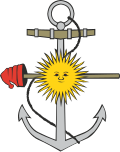| No. | Portrait | Name
(Birth–Death) | Term |
|---|
| Took office | Left office | Time in office |
|---|
Commander of the Naval Operations of the Navy
(Comandante de Operaciones Navales de la Armada) |
|---|
| 1 | | Admiral
Adolfo B. Estévez [ es ]
(1908–1982) | 1 May 1958 | 14 July 1959 | 1 year, 74 days |
| 2 | | Admiral
Alberto P. Vago [ es ]
(1910–2004) | 15 July 1959 | 29 December 1961 | 2 years, 167 days |
| 3 | | Admiral
Agustín Penas [ es ]
(1910–1970) | 29 December 1961 | 2 October 1962 | 277 days |
| 4 | | Admiral
Leandro Maloberti [ es ]
(1912–2000) | 2 October 1962 | 11 December 1962 | 70 days |
| 5 | | Vice Admiral
Enrique Grünwaldt [ es ]
(1913–1986) | 12 December 1962 | 2 April 1963 | 111 days |
| 6 | | Vice Admiral
Eladio Vázquez [ es ]
(1916–2000) | 2 April 1963 | 26 October 1963 | 207 days |
Commander-in-Chief of the Navy
(Comandante en jefe de la Armada) |
|---|
| 7 | | Admiral
Benigno Varela [ es ]
(1917–1996) | 29 October 1963 | 4 October 1968 | 4 years, 344 days |
| 8 | | Admiral
Pedro Gnavi [ es ]
(1917–1990) | 4 October 1968 | 3 January 1972 | 3 years, 91 days |
| 9 | | Admiral
Carlos Coda [ es ]
(1918–2004) | 3 January 1972 | 25 May 1973 | 1 year, 142 days |
General Commander of the Navy
(Comandante general de la Armada) |
|---|
| 10 | | Admiral
Carlos Álvarez [ es ]
(1924–2003) | 25 May 1973 | 6 December 1973 | 195 days |
Commander-in-Chief of the Navy
(Comandante en jefe de la Armada) |
|---|
| 11 | | Admiral
Emilio Eduardo Massera
(1925–2010) | 6 December 1973 | 15 September 1978 | 4 years, 283 days |
| 12 | | Admiral
Armando Lambruschini
(1924–2004) | 15 September 1978 | 11 September 1981 | 2 years, 361 days |
| 13 | | Admiral
Jorge Anaya
(1926–2008) | 11 September 1981 | 1 October 1982 | 1 year, 20 days |
| 14 | | Admiral
Rubén Oscar Franco
(1927–2025) | 1 October 1982 | 5 December 1983 | 1 year, 65 days |
Chief of the General Staff of the Navy
(Jefe del Estado Mayor General de la Armada) |
|---|
| 15 | | Admiral
Ramón Arosa [ es ]
(1931–2025) | 16 December 1983 | 14 July 1989 | 5 years, 210 days |
| 16 | | Admiral
Jorge Ferrer [ es ]
(1933–2009) | 14 July 1989 | 13 July 1993 | 3 years, 364 days |
| 17 | | Admiral
Enrique Molina Pico
(1938–2025) | 13 July 1993 | 24 July 1996 | 3 years, 11 days |
| 18 | | Admiral
Carlos Marrón [ es ]
(1938–2003) | 24 July 1996 | 13 December 1999 | 3 years, 142 days |
| 19 | | Admiral
Joaquín Stella [ es ]
(1942–2017) | 13 December 1999 | 6 June 2003 | 3 years, 175 days |
| 20 | | Admiral
Jorge Godoy
(born 1946) | 6 June 2003 | 22 December 2011 | 8 years, 199 days |
| 21 | | Admiral
Carlos Paz [ es ]
(born 1953) | 22 December 2011 | 15 October 2012 | 298 days |
| 22 | | Admiral
Daniel Alberto Martin [ es ]
(born 1955) | 15 October 2012 | 3 July 2013 | 261 days |
| 23 | | Admiral
Gastón Erice [ es ]
(born 1955) | 3 July 2013 | 14 January 2016 | 2 years, 195 days |
| 24 | | Admiral
Marcelo Srur
(born 1957) | 14 January 2016 | 18 December 2017 | 1 year, 338 days |
| – | | Vice Admiral
José Luis Villán [ es ]
(born 1960)
Acting | 18 December 2017 | 28 September 2018 | 284 days |
| 25 | | Admiral
José Luis Villán [ es ]
(born 1960) | 28 September 2018 | 28 February 2020 | 1 year, 153 days |
| 26 | | Admiral
Julio Guardia
(born 1962) | 28 February 2020 | 2 January 2024 | 3 years, 308 days |
| 27 | | Admiral
Carlos María Allievi [ es ]
(born 1965) | 2 January 2024 | Incumbent | 1 year, 272 days |



























